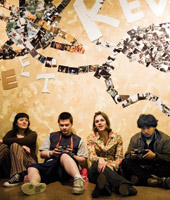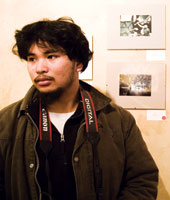 |
|
Autumn 2007 | Volume 30, Number 2
| Alumni
|
|
|
Street Vision
Alumna gives homeless teens a voice — through the lens of a camera
It’s 7 p.m., and a young artist named Jezebel is preparing for her first gallery show. She looks out at a crowd of art patrons sipping San Pellegrino and admiring her work — photography and collage — at the downtown Seattle YMCA’s Triangle Gallery.
The 18-year-old is poised and articulate as she describes the inspiration for her art and her plans for the future. By this time next year, she hopes to be taking university classes and working on her first book. That part isn’t surprising, but something else is: Jezebel slept under a bridge last night.

After leading a workshop on photo montage, Hillary Prag (center) says she “watched in awe” as her students designed and installed this montage called “Street Revolution.” |
How does a young woman — intelligent, ambitious, put-together — wind up living on the streets? Well, first there was the mother who died. Then the guardian who committed suicide. Friends who betrayed her, and the lack of money for rent. It’s a story that other teens — many of whom make their homes in Seattle’s dumpsters, alleys, and parks — can relate to. One door closes, then another, and another.
But just when it seems like life is shutting you out, someone opens a door. For Jezebel, and a group of local homeless teens, that person was Seattle Pacific University alumna Hillary Prag. “I wanted to empower them to use their own innate resources to improve their lives,” Hillary says.
With a degree in sociology and a lifelong passion for photography, the 2006 graduate came up with an unusual solution: photography workshops. Where others saw troublemakers, Prag had a different view of the youth populating Seattle’s streets. “These were artists dying to have some expression,” she explains.
Prag, who put on hold a master’s degree program in international and intercultural communication at the University of Denver, had the vision part down. Now she needed the resources. She applied for a grant from the Seattle Mayor’s Office of Arts and Cultural Affairs and
petitioned the online photo developer Snapfish.com to provide free and discounted photo printing. They both said “yes.”
Shortly after, she took her idea to Seattle’s New Horizon Ministries (NHM) — a nonprofit, interdenominational Christian organization that provides relational support, meals, clothing, and other emergency services to homeless youth — and its staff immediately offered her a place on the calendar. “When Hillary submitted her proposal for the class, I was excited that someone would want to commit their time to helping the youth explore the art of photography,” says NHM’s life discovery coordinator, Naomi Yonemura.
From October 2006 to March 2007, Prag offered photography workshops at New Horizons as well as at Seattle Urban Academy, a street school in the Rainier Valley. Her class, called “Street Vision,” was an instant hit.
After a few lessons about composition, lighting, and camera technique, Prag distributed cameras and film and set her pupils loose. Their assignment? To document their lives on the street in the most authentic way possible.
The following week, Prage collected and developed the film. She took a look at some of the images while in her car. “I almost crashed — they were so moving,” she recalls. “It was life as they knew it, and it was nothing a professional photojournalist could have taken.”
In the months that followed, the photos the students captured showed a rare and personal side of life on the streets — images that were often dark and chaotic: a group of young men sleeping in a dumpster, a city street lit from the glow of a drug pipe, a dead rat, the lonely view from below a skyscraper, police patrolling Westlake Center.
Yet there was humor, joy, and light in the images, too: a sunrise over Pike Place Market, a rainbow, and friends smiling. “Their lives are incredibly challenging,” explains Prag, but through the images, she says, “it’s like they’re saying, ‘I’ve been dealt a bad hand, but I’m still finding my way.’”
“The class taught basic photography techniques, but it also helped the youth explore why they take pictures, what message they are conveying, and why certain pictures speak to them and others,” adds Yonemura.
It’s art, says Prag, but it’s also an exercise in self-reflection. “Encouraging kids who are very fragile to take this kind of risk is like asking them to walk through fire.”
Prag beams with pride when she describes her students’ journeys. For instance, before completing the class, one teen made a remarkable transformation. He moved home with his family, and even got a job. “I think it was partly to do with the fact that he had seen his life in 4-by-6-inch images each week,” Prag explains. “He saw his life in print, and he made changes.”
Not all the stories had happy endings. Perhaps most difficult for Prag, she says, was knowing that after class, many of her students would have to beg for dinner money and end up sleeping in an alley. “It was heart-wrenching to know that these kids were going to spend the night sleeping in recycle bins after class.”
When “Street Vision” ended, Prag took her newfound angle on the world to Boston, where she spent the summer leading street youth in arts and photography workshops. One of her most memorable moments in Boston occurred when she met up with a former student from Seattle. He recognized her and enthusiastically announced their reunion: “Guys, you won’t believe this!” he said, pointing in her direction. “Her photography class was one of the best things that happened to me in Seattle. This makes at least my day, if not my week!”
This fall, Prag began the graduate program she postponed so many months ago.
“As a student at SPU, I was equipped to change the world,” she says. “As a graduate, I’m learning to realize what that means for me. Right now, it means being content when exactly one young person finds freedom in telling her story through photographs.
“It is in these moments that I am learning to be at peace with myself. It is for these moments that I’m incredibly grateful.”
—By Sarah Jio
—Photos by Luke Rutan
Back to the top
Back to Alumni Home
|
|
 |
 PRM agrees with most yourng artisits who describe photography as both empowering and dangerous for street-involved youth. It may strengthen their identity, but at the high cost of vunerability.
PRM agrees with most yourng artisits who describe photography as both empowering and dangerous for street-involved youth. It may strengthen their identity, but at the high cost of vunerability.
For more photos, visit the Photography Gallery. |
 |